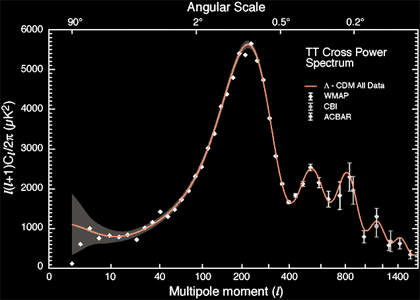
Inflation
Image: Graph of the power (temperature) variation with multipole moment in the Fourier expansion in spherical harmonics of temperature across the sky. The power spectrum is consistent with the cold dark matter theory of structure formation with a negative cosmological constant; the scalar spectral index derived from it is consistent with the simplest models of cosmic inflation.
Cosmic inflation is the exponential expansion of the very early universe driven by ‘slow-roll’ of a hypothetical scalar field from a false to a true vacuum, lasting between 10-36 to 10-32 seconds, and leading to the end of that time to an expansion of a factor of about 1060, and to ‘reheating’ -- the dumping of energy from the inflaton potential as a quark-gluon plasma, whereupon conventional big bang cosmology in combination with the standard model take over. Retrodicting from the visible universe to these energy scales, the inflationary epoch would concluded with a volume of space about the size of a golf ball (compare Lemaitre’s ‘cosmic egg’). The subsequent evolution of this region involved a much slower expansion, in accordance with conventional big bang cosmology, to the universe as presently observed.
This golf-ball size object is only part (a ‘causal patch’) of a more extended object, whose size and topology is unknown. According to one version of inflationary cosmology, ‘eternal inflation’ as proposed by Alexander Vilenkin in 1983, the initial inflaton field slow-role can proceed in both directions, driven by quantum fluctuations. Since on climbing the potential hill of the initial false vacuum inflation occurs at an even greater rate, throughout most of the universe measured in terms of volume inflation is always occurring. The result is the conception of the universe as a ‘multiverse’. This is quite distinct from the multiverse of superstring theory, where it is supposed, by Susskind among others, that every vacuum state is realized, or from the multiverse of the many-worlds theory of quantum mechanics as proposed by Everett.
Since the inflationary period involved an increase in size by a factor of 1060, the initial dimensions of the observed universe would have been ultra-microscopic. This solves both the horizon problem, one of the rationales for the first model of inflation as proposed by Alan Guth in 1980.
Despite its speculative character, and the complete absence to date of any evidence for a scalar inflaton field, inflationary cosmology has scored some notable successes, particularly in correctly predicting the power spectrum in anisotropies in the cosmological microwave background, as revealed by the COBE observations. In particular it accurately predicts the observed value of the ‘scalar spectral index’, a number that compares the CMB temperature fluctuations seen over large scales to those seen at small scales. The simplest slow-roll models of inflationary cosmology predict this number to about 0.95. The COBE survey determined its value to be 0.95 ±0.02, a spectacular confirmation of the theory.
Links
An introduction to cosmological inflation (1999), by Andrew Liddle >
Symmetry: Dimensions to Particle Physics. The Growth of Inflation >
Sky and Telescope: WMAP bolsters case for cosmic inflation >
New Scientist 3 March 2007. Inside Inflation: after the big bang >
Multimedia
Alan Guth: Cosmic inflation and the accelerating universe, Part 1 >
Alan Gurth: Cosmic inflation and the accelerating universe, Part 2 >
SETI talk: Adrew Linde, ‘Universe or multiverse?’ >
Neil Turok, ‘From zero to infinity, and beyond’ >


